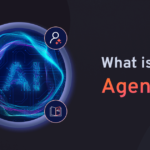Table of Contents

Introduction: Top 5 AI Trends 2025 Business
The landscape of artificial intelligence is evolving at an unprecedented pace. What was once futuristic is now becoming an everyday reality, especially as we step further into 2025. This year marks a significant shift, with AI moving beyond novelty to become an indispensable tool across industries. For AI trends 2025 business strategies are already being reshaped. But with so much noise, how do you identify the truly transformative trends that will impact your bottom line? This article cuts through the hype to reveal the five most impactful AI trends 2025 business leaders need to understand, redefining operations and strategies, along with practical steps to ensure your organization is ready to capitalize on these advancements.
1. The Proliferation of Generative AI Integration (GenAI Everywhere) for Your Business
Generative AI has been a game-changer, and in 2025, its integration into existing applications and workflows is reaching new heights. From content creation to code generation and even nuanced customer interactions, GenAI is becoming seamlessly embedded, marking a significant AI trend 2025 business will widely adopt.
What’s new in GenAI for 2025: Expect more sophisticated, specialized GenAI models tailored for specific industry needs. We’re moving beyond generic text generation to AI that can produce highly accurate, context-aware content, designs, and even synthetic data. Think beyond basic chatbots to AI systems capable of drafting complex legal documents, designing intricate architectural blueprints, or composing personalized musical scores for marketing campaigns. The focus is on hyper-specialization and real-time, adaptive generation.
Impact on Business: How GenAI will transform your operations:
- Increased Efficiency in Content Creation: Marketing teams can generate high-quality blog posts, social media captions, email campaigns, and even video scripts in minutes, allowing them to focus on strategy and refinement.
- Personalized Marketing at Scale: GenAI can analyze individual customer preferences and generate unique ad copy, product recommendations, and offers for millions of users simultaneously, driving higher engagement and conversion.
- Accelerated Product Development: Engineers can use GenAI to quickly prototype code, design new product features, or even simulate manufacturing processes, drastically cutting development cycles.
- Automated Task Completion Across Departments: From drafting initial HR policies to summarizing lengthy research papers for R&D, GenAI automates cognitive tasks, freeing up human capital for higher-value activities.
How to Prepare Your Business for GenAI Proliferation:
- Identify Integration Opportunities: Conduct a thorough audit of your current tech stack and operational workflows. Pinpoint repetitive cognitive tasks or areas where creative output is a bottleneck. Identify where GenAI APIs (Application Programming Interfaces) can be seamlessly integrated to automate these tasks or enhance creative output.
- Invest in Skilling Your Workforce: It’s not about replacing humans but augmenting them. Train your teams to effectively prompt, supervise, and utilize GenAI tools. Shift the focus from manual creation to critical thinking, refinement, ethical oversight, and strategic application of AI-generated outputs. Develop “AI literacy” programs for all employees.
- Establish Robust Ethical Guidelines: The power of GenAI comes with responsibility. Develop clear, internal policies for GenAI use to ensure accuracy, prevent the propagation of biases, avoid copyright infringements, and maintain your brand’s authentic voice and reputation. Emphasize human review and accountability for all AI-generated content.
2. Advanced Multimodal AI: Understanding the World Holistically for Stronger AI Trends 2025 Business Integration
While many AI models previously focused on a single data type (text, image, audio), multimodal AI is now capable of processing and understanding information from multiple modalities simultaneously. This holistic understanding is a game-changer among AI trends 2025 business leaders are increasingly investing in.
What’s new in Multimodal AI for 2025: Expect AI systems that can analyze a video, understand the spoken dialogue, identify objects, faces, and emotions in the scene, and connect it all to relevant textual information from a knowledge base. This allows for far richer contextual understanding than ever before. For example, an AI could analyze a customer service call, identify vocal tone shifts, interpret facial expressions from a video feed, and cross-reference the spoken words with customer history to pinpoint frustration and suggest appropriate solutions in real-time.
Impact on Business: The benefits of holistic AI understanding:
- Enhanced Customer Service: Imagine a customer service bot that can not only understand typed queries but also analyze a customer’s tone of voice and even interpret gestures during a video call to gauge their sentiment and provide more empathetic and effective support.
- Advanced Data Analysis from Diverse Sources: Businesses can gain deeper insights by analyzing unstructured data from various sources – satellite imagery combined with weather data and sales figures, or social media text combined with user-uploaded images and videos – to predict market shifts or optimize logistics.
- More Intuitive Human-AI Interactions: Future interfaces will allow users to interact with AI using a combination of voice, gestures, and text, making AI tools more accessible and natural to use.
- Improved Security and Monitoring: Multimodal AI can analyze surveillance footage for suspicious activities, combining visual cues with audio patterns to detect threats more accurately.
How to Prepare Your Business for Multimodal AI:
- Diversify Data Collection Strategies: Expand your data collection efforts beyond traditional text and numerical data. Explore capturing and analyzing various data types (audio, video, images) relevant to your operations, such as customer interaction recordings, production line visuals, or retail foot traffic patterns.
- Pilot Multimodal Applications: Start small by experimenting with tools that leverage multimodal AI for specific insights. This could involve using AI to analyze customer feedback from multiple channels or optimizing quality control by combining visual inspection with sound analysis in manufacturing.
- Focus on Data Quality and Labeling: The performance of multimodal AI heavily relies on the quality and accurate labeling of your diverse datasets. Invest in robust data governance, cleansing processes, and annotation teams to ensure the AI receives clean, well-structured input for training.
3. AI as a Productivity Partner: From Automation to Augmentation for Every Employee
AI’s role in the workplace is shifting from simply automating repetitive tasks to becoming a true partner that augments human capabilities. This evolution is one of the most exciting AI trends 2025 business professionals are eager to embrace.
What’s new in AI Productivity for 2025: AI assistants are becoming significantly more intelligent and proactive. Beyond simple task automation, they now offer real-time, context-aware suggestions, synthesize complex information from vast datasets, draft sophisticated responses, and even manage project timelines across various professional tools (e.g., enhanced Microsoft Copilot features, advanced CRM AI, intelligent design assistants). They are moving from “doing tasks for you” to “thinking alongside you.”
Impact on Business: Boosting output with AI as your co-pilot:
- Significant Improvements in Employee Productivity: By offloading time-consuming administrative tasks like email management, meeting summarization, or initial report drafting, AI frees employees to focus on strategic thinking, problem-solving, and creative work.
- Reduction in Time Spent on Administrative Tasks: Professionals across all departments will experience a marked decrease in time dedicated to mundane, repetitive tasks, leading to higher job satisfaction and engagement.
- Enhanced Decision-Making Through AI-Driven Insights: AI can quickly process and analyze vast amounts of data, presenting key insights and potential outcomes, enabling faster, more informed, and data-backed decisions.
- A Shift Towards More Strategic, Creative Human Work: With AI handling the routine, human employees can elevate their roles, focusing on innovation, complex problem-solving, relationship building, and tasks requiring emotional intelligence.
How to Prepare Your Business for AI Productivity Partners:
- Integrate AI Productivity Tools Thoughtfully: Don’t just implement AI for AI’s sake. Identify specific pain points and workflows where AI-powered assistants and tools can genuinely boost efficiency and reduce cognitive load. Examples include AI-powered scheduling, document summarization, or code completion tools.
- Foster a “Co-Pilot” Mindset Among Employees: Encourage employees to view AI as a collaborative partner rather than a replacement. Emphasize how AI can elevate their existing work, provide insights, and handle routine tasks, allowing them to achieve more and focus on high-value contributions.
- Measure Tangible Productivity Gains: Establish clear Key Performance Indicators (KPIs) before and after AI integration. Track metrics such as time saved on specific tasks, project completion rates, accuracy improvements, and employee satisfaction to assess the tangible benefits and ROI of AI integration.
4. Hyper-Personalization at Scale Driven by AI: A Key AI Trend 2025 Business Growth Driver
The ability to deliver truly personalized experiences to customers is no longer a luxury but a necessity, and AI is the engine driving this at an unprecedented scale. This is arguably one of the most critical AI trends 2025 business will leverage for competitive advantage.
What’s new in AI-driven Hyper-Personalization for 2025: AI models are now sophisticated enough to analyze vast amounts of granular customer data – encompassing individual preferences, real-time behavior, past interactions, purchase history, demographic data, and even emotional responses – to create highly individualized recommendations, content, product offerings, and even dynamic pricing in real-time. This isn’t just about “you might also like”; it’s about anticipating needs and creating bespoke experiences.
Impact on Business: The power of bespoke customer experiences:
- Increased Customer Satisfaction and Loyalty: When customers feel understood and receive relevant, tailored experiences, their satisfaction skyrockets, leading to stronger brand loyalty and repeat business.
- Higher Conversion Rates: Personalized recommendations and content are far more likely to resonate with customers, leading to significantly improved conversion rates across e-commerce, marketing campaigns, and sales funnels.
- Optimized Marketing Campaigns: AI can dynamically adjust marketing messages, channels, and timing for each individual, maximizing the effectiveness of every campaign spend and reducing wasted ad impressions.
- More Efficient Resource Allocation: By understanding individual customer preferences and potential, businesses can allocate sales and support resources more efficiently, focusing on high-value interactions.
How to Prepare Your Business for AI-Powered Hyper-Personalization:
- Centralize and Unify Customer Data: Break down data silos. Ensure your customer data (from CRM, ERP, website analytics, social media, loyalty programs) is unified, clean, and easily accessible to AI systems for comprehensive analysis and 360-degree customer views.
- Implement AI-Powered Personalization Platforms: Explore and integrate specialized tools and platforms that leverage AI for dynamic content delivery, product recommendations, tailored communications (email, app notifications, website content), and personalized customer journeys.
- Prioritize and Respect Data Privacy: With great data comes great responsibility. Prioritize ethical data collection and usage. Ensure absolute transparency with your customers about how their data is used, obtain explicit consent where required, and ensure full compliance with evolving data privacy regulations (e.g., GDPR, CCPA, India’s DPDP Act, if applicable). Build trust by demonstrating responsible data stewardship.
5. Explainable AI (XAI) and Trust in AI Systems: A Critical AI Trend 2025 Business Operations Require
As AI becomes more pervasive and critical to business operations, the demand for transparency and understanding of how AI makes decisions is paramount. Explainable AI (XAI) directly addresses this by making AI models more interpretable and less of a “black box.” This is a crucial AI trend 2025 business leaders cannot afford to overlook.
What’s new in XAI for 2025: Advancements in XAI are providing developers, business users, and regulators with clearer, more intuitive insights into the reasoning behind AI outputs. This includes techniques that highlight which input features contributed most to a decision, visualize decision pathways, or generate human-readable explanations of complex model behavior. This fosters greater trust, enables better troubleshooting, and facilitates regulatory compliance.
Impact on Business: Building confidence and compliance with AI:
- Increased Confidence in AI-Driven Decisions: When businesses understand why an AI made a particular recommendation (e.g., a loan approval, a medical diagnosis, a fraud alert), they can trust the system more and make better-informed human interventions where necessary.
- Easier Identification and Mitigation of Biases: XAI helps pinpoint if an AI model is making discriminatory or biased decisions based on unfair data or flawed algorithms, allowing for prompt corrective action.
- Improved Regulatory Compliance: In heavily regulated industries like finance, healthcare, and law, XAI is essential for demonstrating compliance with non-discrimination laws, audit requirements, and risk management protocols.
- Better Auditability of AI Systems: XAI provides the necessary tools for internal and external auditors to review AI systems, ensuring they meet performance, ethical, and legal standards.
- Enhanced Debugging and Performance Optimization: Developers can use XAI to understand where models are failing or underperforming, leading to more efficient debugging and continuous improvement.
How to Prepare Your Business for Explainable AI (XAI):
- Prioritize XAI Capabilities in AI Solutions: When developing in-house AI solutions or adopting third-party AI products, make robust XAI capabilities a non-negotiable requirement. Inquire about the interpretability of models and the tools provided for understanding their outputs.
- Educate Stakeholders on XAI Principles: Train your data scientists, business analysts, legal teams, and even senior management on the importance of XAI and how to interpret AI explanations. This fosters a common understanding and builds confidence across the organization.
- Implement Strong AI Governance Frameworks: Establish clear governance frameworks for the entire lifecycle of AI deployment. This includes mechanisms for continuous monitoring of AI performance, regular auditing for bias and fairness, and clear processes for addressing potential issues or adverse impacts. Integrate XAI insights into these governance processes.
Conclusion: Top 5 AI Trends 2025 Business
2025 is set to be a pivotal year for AI adoption and innovation, particularly as these AI trends 2025 business leaders are observing come to fruition. By understanding these five transformative trends – the widespread integration of GenAI, the power of multimodal AI, AI as a productivity partner, hyper-personalization, and the growing importance of XAI – businesses can strategically position themselves for unparalleled success. The key is not just to observe these changes but to actively embrace and implement them, transforming challenges into opportunities for unprecedented growth, efficiency, and competitive advantage. The future of business is inextricably linked with AI. Are you ready to lead the AI revolution in your industry and ensure your AI trends 2025 business strategy is robust?








